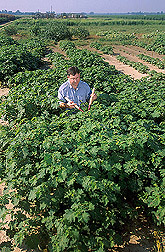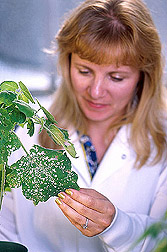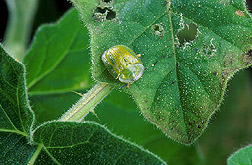ARS Researchers Winning Battle With Noxious Weed
|
|
|
|
Small victories are being reported by the Agricultural Research Service (ARS) in the war against tropical soda apple (Solanum viarum), a nonnative, invasive weed of pastures, row crops, forests, and urban areas throughout the southeastern United States.
Tropical soda apple (TSA) was first observed in Florida in 1988, causing little concern with fewer than 2,000 acres affected. Just 6 years later, however, researchers estimated that more than 1 million acres were infested. Charles T. Bryson, an ARS research botanist with the Southern Weed Science Research Unit in Stoneville, Mississippi, says researchers believe the resilient weed has now been eradicated from Louisiana, Tennessee, and Pennsylvania, but efforts must not become lax. A recent report from the Stoneville unit shows that “a combination of late summer mowing, fall herbicide application, and normal winter conditions can prevent TSA survival.” Although the plant is known to overwinter as far north as 35 degrees latitude, Bryson says early detection and other control methods by persistent cattle ranchers in several states have prevented cattle from spreading the weed northward. He says Florida cattle ranchers were aided by recent severe winters and drought. |
|
|
The Cattle Connection
Cattle cannot resist the sweet smell of TSA's golf-ball-sized, yellow fruit, Bryson says. “Cows will reach into the prickly plant with their long tongue and snatch the mature fruit off without getting injured,” he says. When cattle are moved to neighboring states for winter feeding, they transport ingested seeds with them. The seeds are also spread by way of composted manure, grass seed, sod, or hay, as well as by deer and other wildlife. TSA infests pastureland by outcompeting forage grasses, and the prickly foliage drives cows from shaded areas, leading to heat stress. Losses to Florida cattle ranchers are estimated to be about $11 million annually. Each TSA plant can produce more than 50,000 seeds. Cattle provide an ideal method of transporting the plant because a single cowpat can hold 150 or more seeds. The plants can also host crop viruses, such as cucumber mosaic virus, potato leafroll virus, potato virus Y, tomato mosaic, or the potato fungusAlternaria solani. Poison Apple TSA was added to the Federal Noxious Weed List in August 1995. This list was created by congressional act to prevent the spread of weeds that interfere with the growth of useful plants, cause disease, or have other adverse effects on U.S. agriculture, commerce, or public health. An exotic species native to South America, TSA has no real redeeming value, according to Bryson. In fact, he says its toxic alkaloids can be detrimental to human health if ingested. It can grow almost anywhere—from lawns to forested areas, in direct sun or in shade, he says. Bryson calls the prickly weed armed and dangerous and says it is generally unpleasant to be around. It outcompetes forage grasses, and its thornlike prickles pose a threat to workers picking vegetable crops in infested areas. Treading Lightly with Control Measures TSA is a member of the Solanaceae family, commonly known as nightshades, which includes some of the most nutritious plants—potato, eggplant, tomato—and some of the most poisonous. Because there are so many species of nightshade, with varying degrees of value to people, any biological control agent used to combat TSA would have to be chosen carefully, according to Bryson. “A biological control agent must be host specific, otherwise it can harm crops or native nightshades that don't pose a threat,” Bryson says. Although TSA's grip may have lessened for now, alternative control methods are being sought. C. Douglas Boyette, a plant pathologist in the Stoneville weed unit, is looking at nightshade fungal pathogens to use as bioherbicides for controlling exotic invasives and agronomically important weeds. He is examining Fusarium, a fungus that affects TSA and other plants, to find ways to increase its potency through formulation. Although it has been successful in the greenhouse, Boyette says there have been only limited field tests. Another Stoneville scientist, entomologist Shaharra J. Usnick, is testing insects from South America as biocontrol agents for TSA.—By Jim Core, Agricultural Research Service Information Staff. This research is part of Crop Protection and Quarantine, an ARS National Program (#304) described on the World Wide Web at http://www.nps.ars.usda.gov. Charles T. Bryson is with the USDA-ARS Southern Weed Science Research Unit, P.O. Box 350, Stoneville, MS 38776; phone (662) 686-5259, fax (662) 686-5422.
|
|
|
Tiny Tortoise Beetle Might Do the Trick
At the South American Biological Control Laboratory in Buenos Aires, Argentina, ARS researchers led by Daniel Gandolfo think they may have found a way to halt the dramatic spread of tropical soda apple (TSA). Extensive screening of possible biological controls in 1996 and 1997 led the scientists to the 5- to 6-millimeter-long tortoise beetle, Gratiana boliviana. It appears that its fecundity, longevity, and host-specificity may make it an ideal natural control agent.
In both larval and adult stages, G. boliviana beetles chew holes in the upper leaves of the plant, significantly reducing the weed's survivability.
The tiny, iridescent beetles—of turquoise and gold—will soon be put to the test in rangelands and improved pastures across Pennsylvania, the southern United States, and Puerto Rico.
But before researchers could apply for U.S. release of the beetle to control TSA, one significant hurdle had to be overcome: They had to make sure that G. boliviana would not devour nontarget plants.
“Since TSA is related to several widespread crops, a risk assessment had to be performed for them, particularly eggplant, Solanum melongena, the most defenseless crop in the family,” says Gandolfo.
Recent studies in Argentina and quarantine facilities in Gainesville, Florida, have eliminated that concern. According to Gandolfo, extensive tests were conducted to determine if eggplant would be a suitable host for G. boliviana. “The experiment showed that the beetle has a distinct preference for TSA,” he says. Eggplant-fed females displayed a 98 percent decrease in the number of eggs laid, and 30 percent of those had anomalous egg cases. In addition, the beetle's life-span was significantly shortened on eggplant, and after 30 days adults began to resorb their ovaries.
If, as anticipated, the beetle's performance continues to confirm these findings, G. boliviana could be approved for release in the United States sometime this year.—By Jesús García, formerly with ARS.
Daniel Gandolfo is with the USDA-ARS South American Biological Control Laboratory, Bolivar 1559 - (B1686EFA) Hurlingham, Buenos Aires, Argentina; phone 54-11-4662-0999, fax ext. 104.
"ARS Researchers Winning Battle With Noxious Weed" was published in the January 2002 issue of Agricultural Research magazine. |









